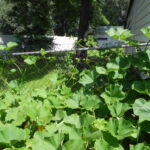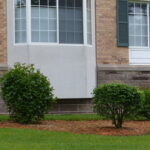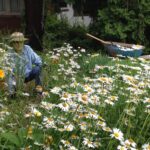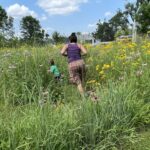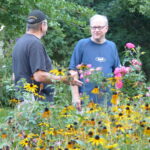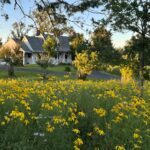
Prairie flowers dance on a knoll.
Motorists passing our yard must think we have a messy yard. Instead of the clipped and sprayed yards of neighbors, ours is a dancing field of tall wildflowers and native grasses. Many consider them “weeds”. Our yard is unconventional, healthy, and beautiful. It attracts desirable wildlife and is dynamic. Visitors, especially children, love walking through six-foot-tall grasses on our labyrinth pathway. To us, pollinators and birds, it’s heaven, not a mess. It is a naturally landscaped yard.
Sugar Grove Farm Paves the Way
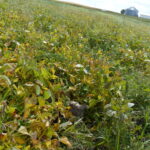
The space between crops is productive in a different way.
Last summer Rich toured Rodale Institute’s plantings at Sugar Grove Farm near Cedar Rapids. Researcher Linda Sturm led him and farmers to plots of vegetables and fields of corn and soybeans before stopping by a long row of what looked like weeds with wildflowers mixed in.
“This is an unproductive area, wasted ground, that could have been planted to corn,” a farmer remarked. Linda countered that it is likely the most productive land on the farm. “It’s the home base for pollinators and birds. They forage in nearby crops to collect nectar and eat insect pests,” she said.
Natural Yards Can Reduce Pests
Same thing at Winding Pathways. Our vegetable garden is amazingly productive despite never using insecticides and only mowing sparingly. Butterflies visit squash, cucumbers, okra and other crops, spreading pollen while wrens constantly forage for insects to feed their hungry young.
A clipped and sprayed lawn is only slightly more attractive to wildlife than pavement. There’s no place for tiny beneficial creatures to live.
- Birds and insects forage in the garden.
- This yard offers little to wildlife.
Create Pollinator Patches
Homeowners with small yards can help pollinators and birds by creating islands or strips of welcoming habitat, perhaps in the backyard or along the property line. Linda Strum created habitats within farm fields, and suburban homeowners can enjoy the same benefits. Worry about the neighbor’s reaction? Just create a habitat in the backyard out of sight of passersby.
- Native and cultivated plants brighten a front yard.
- Adults and children revel in the natural yard.
- Converting a yard to more natural plants brings joy.
Adding birdhouses adds to wildlife fun. We love watching house wrens hunt insects and bring their catch to their babies nestled in a wooden birdhouse dangling down from our porch ceiling.
Given a bit of imagination and fun work even the smallest yard can appear tidy, be aesthetically diverse, and provide homes for butterflies and wondrous spaces for kids and adults.

